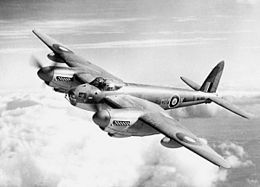
Back مقاتلة ثقيلة Arabic Těžký stíhací letoun Czech Zerstörer (Flugzeug) German Βαρύ μαχητικό αεροσκάφος Greek Caza pesado Spanish جنگنده سنگین Persian Chasseur lourd French Pesawat tempur berat ID Zerstörer Italian Pesawat pejuang berat Malay

A heavy fighter is a historic category of fighter aircraft produced in the 1930s and 1940s, designed to carry heavier weapons or operate at longer ranges than light fighter aircraft. To achieve performance, most heavy fighters were twin-engine, and many had multi-place crews; this was in contrast to light fighters, which were typically single-engine and single-crew aircraft. In Germany, these larger fighters were known as Zerstörer ("destroyers").
The heavy fighter was a major design class during the pre-World War II period, conceived as long-range escort fighters or heavily armed bomber destroyers. Most such designs failed in this mission, as they could not maneuver quickly enough against single-engine fighters. Most notable among such designs was the Messerschmitt Bf 110, which suffered great losses during the Battle of Britain. An exception was the American Lockheed P-38 Lightning,[1][2][3] which proved an effective heavy fighter; even against smaller, lighter, single-engine aircraft and particularly in the Pacific theater.[4]
Many twin-engine heavy fighters found their niche as night fighters, especially in the bomber-destroyer role; or as fighter-bombers, roughly analogous to modern strike fighters. Among such conversions was the Bf 110, which served as a relatively successful night fighter, ground attacker, and fighter-bomber for most of the war;[5] and the Bristol Beaufighter, which emerged as a major anti-shipping strike fighter of the Royal Air Force.[6] Some heavy fighters did find success in the roles they were designed for; the de Havilland Mosquito, simultaneously developed as a light bomber, fighter and photo-reconnaissance aircraft, excelled in its originally proposed role as a fast light bomber.
Although not always contemporaneously referred to explicitly as “heavy fighters,” nearly every single combatant of WWII fielded or experimented with twin-engine multi-role combat aircraft.
- ^ Dean, Francis (1997). America's Hundred Thousand The US Production Fighter Aircraft of World War II. USA: Schiffer Pub. p. 160. ISBN 9780764300721.
The P-38 was a large heavy fighter...
- ^ Jackson, Robert (2010). "Lockheed P-38 Lightning". 101 Great Fighters (1 ed.). New York, New York: The Rosen Publishing Group, Inc. p. 36. ISBN 9781435835979.
The P-38A heavy fighter...
- ^ Diamond, Jon (2015). "Chapter 8: American Air and Sea Interdiction". New Guinea: The Allied Jungle Campaign in WWII (1 ed.). Mechanicsburg, PA: Stackpole Books. p. 182. ISBN 9780811715560.
The P-38 was a heavy fighter...
- ^ Stanaway, John (15 April 1997). P-38 Lightning Aces of the Pacific and CBI. New York, NY, USA: Bloomsbury USA. p. 14. ISBN 9781855326330. Retrieved 30 January 2020.
- ^ "Germany's Best Nightfighter - Messerschmitt Bf 110 in 25 Photos". 3 August 2018.
- ^ Bishop, Chris (1998). "Anti-Shipping Aircraft". The Encyclopedia of Weapons of World War II. Singapore, Republic of Singapore. pp. 383–384. ISBN 0760710228.
...the RAF began to achieve worthwhile successes when such aircraft as the... Bristol Beaufighter...;" "...a specialist anti-shipping strike aircraft...
{{cite book}}: CS1 maint: location missing publisher (link)
© MMXXIII Rich X Search. We shall prevail. All rights reserved. Rich X Search